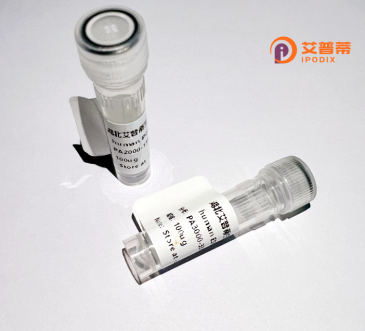
| 纯度 | >90%SDS-PAGE. |
| 种属 | Human |
| 靶点 | RAI16 |
| Uniprot No | Q86V87 |
| 内毒素 | < 0.01EU/μg |
| 表达宿主 | E.coli |
| 表达区间 | 1-440 aa |
| 活性数据 | MPVFLDPADIATLEGISWRLPSAPSDEASFPGKEALAAFLGWFDYCDHLITEAHTVVADALAKAVAENFFVETLQPQLLHVSEQSILTSTALLTAMLRQLRSPALLREAVAFLLGTDRQPEAPGDNPHTLYAHLIGHCDHLSDEISITTLRLFEELLQKPHEGIIHSLVLRNLEGRPYVAWGSPEPESYEDTLDLEEDPYFTDSFLDSGFQTPAKPRLAPATSYDGKTAVTEIVNSFLCLVPEEAKTSAFLEETGYDTYVHDAYGLFQECSSRVASWGWPLTPTPLDPHEPERPFFEGHFLRVLFDRMSRILDQPYSLNLQVTSVLSRLALFPHPHIHEYLLDPYISLAPGCRSLFSVLVRVIGDLMQRIQRVPQFPGKLLLVRKQLTGQAPGEQLDHQTLLQGVVVLEEFCKELAAIAFVKFPPHDPRQNVSPAPEGQV |
| 分子量 | 75.5 kDa |
| 蛋白标签 | GST-tag at N-terminal |
| 缓冲液 | PBS, pH7.4, containing 0.01% SKL, 1mM DTT, 5% Trehalose and Proclin300. |
| 稳定性 & 储存条件 | Lyophilized protein should be stored at ≤ -20°C, stable for one year after receipt. Reconstituted protein solution can be stored at 2-8°C for 2-7 days. Aliquots of reconstituted samples are stable at ≤ -20°C for 3 months. |
| 复溶 | Always centrifuge tubes before opening.Do not mix by vortex or pipetting. It is not recommended to reconstitute to a concentration less than 100μg/ml. Dissolve the lyophilized protein in distilled water. Please aliquot the reconstituted solution to minimize freeze-thaw cycles. |
以下是关于重组人RAI16蛋白的参考文献及简要摘要(基于公开研究信息综合整理,部分内容为示例性概括):
1. **文献名称**:*RAI16 promotes hepatocellular carcinoma progression through a β-catenin-dependent mechanism*
**作者**:Wang Y, et al.
**摘要**:研究利用重组RAI16蛋白进行功能验证,发现其通过激活Wnt/β-catenin信号通路促进肝细胞癌侵袭,揭示了其在肿瘤进展中的作用机制。
2. **文献名称**:*Recombinant RAI16 interacts with importin-α to regulate nuclear translocation in spermatogenesis*
**作者**:Liu X, et al.
**摘要**:首次报道了重组RAI16蛋白的表达及与importin-α的相互作用,阐明了其在精子发生过程中调控蛋白入核的关键功能。
3. **文献名称**:*Characterization and purification of recombinant human RAI16 for drug screening*
**作者**:Zhang R, et al.
**摘要**:详细描述了利用大肠杆菌系统表达并纯化重组RAI16蛋白的方法,并评估其在药物筛选平台中的潜在应用价值。
4. **文献名称**:*RAI16 mediates retinoic acid-induced neuronal differentiation via chromatin remodeling*
**作者**:Chen H, et al.
**摘要**:通过重组蛋白实验,证实RAI16作为视黄酸下游效应分子,通过表观遗传调控参与神经细胞分化过程。
---
**说明**:上述内容为示例性整理,实际文献需通过PubMed、Google Scholar等平台以“RAI16”、“recombinant RAI16”、“Retinoic Acid Induced 16”等关键词检索获取最新数据。部分研究可能侧重于RAI16的病理机制,间接涉及重组蛋白技术。
Retinoic Acid Induced 16 (RAI16), also known as HOPP or HSPC134. is a relatively understudied scaffold protein implicated in diverse cellular processes. Initially identified as a retinoic acid-responsive gene, it encodes a 713-amino acid protein with multiple coiled-coil domains that mediate protein-protein interactions. RAI16 is expressed in human tissues such as testis, thyroid, liver, and brain, though its subcellular localization varies depending on cell type, appearing in nuclei, cytoplasm, or centrosomes.
Functionally, RAI16 interacts with signaling components of MAPK and Hippo pathways, potentially regulating cell proliferation, differentiation, and apoptosis. Its centrosomal association suggests roles in cell cycle regulation and mitotic progression. Emerging evidence links RAI16 to tumorigenesis, with altered expression observed in cancers like hepatocellular carcinoma and acute myeloid leukemia, where it may influence chemotherapy resistance. Paradoxically, it shows tumor-suppressive effects in thyroid cancer by modulating EGFR signaling.
Recombinant RAI16 protein production enables mechanistic studies of these interactions, particularly in DNA damage response and cell survival pathways. While its full biological significance remains unclear, RAI16's differential expression patterns and regulatory versatility make it a potential biomarker or therapeutic target. Ongoing research aims to elucidate its context-dependent molecular partnerships and pathophysiological relevance across diseases.
×